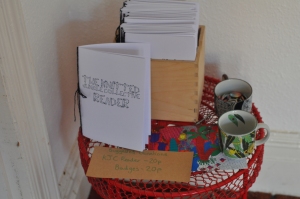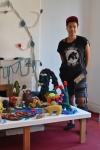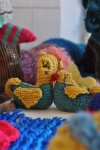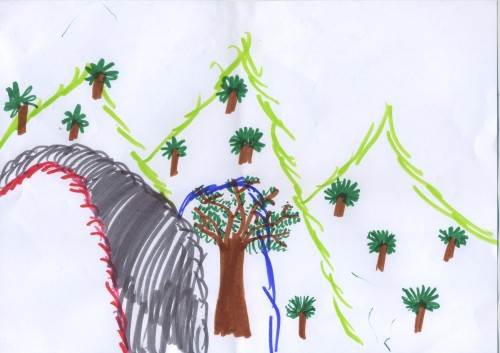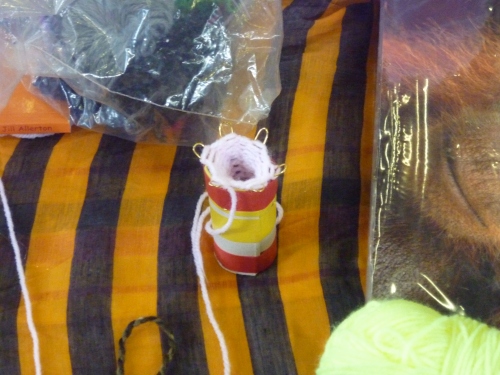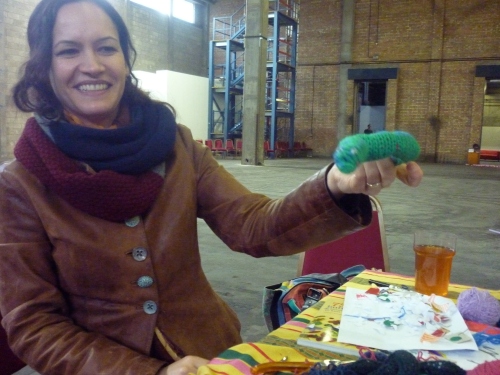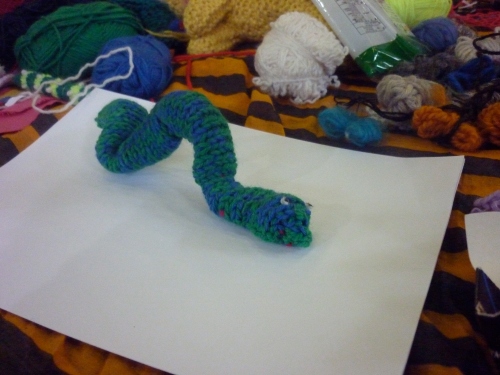Hi everyone,
The KJC has gone into hibernation and who knows when it will awake but while we wait for it to awaken here is an essay written by art critic William McCrory taken from the Knitted Jungle Collective Reader that accompanied our show at the Kunsthaus 15 Gallery, Nottingham.
The Knitted Jungle Collective: A Critical Introduction
In this text I will aim to explore the cultural practice of The Knitted Jungle Collective. The initial objective will be to chart the origination of the KJC and secondly to describe its contents and form. Also, through consideration of Glen Adamson’s Circular Logic: Some Thoughts Around Craftivism and Ele Carpenter’s Activist Tendencies In Craft, I hope to consider the extent to which The KJC can be considered a Craftivist project.
The KJC came into being through the serendipitous discovery of books containing basic knitting patterns for knitting animals. As they explain:
“[We] discovered these books that are for knitting for children… How to teach 8 or 9 year olds how to knit and I thought oh look, there are knitting patterns that even I could do. So we started making animals, [we] needed a project and this was a good place to start.”
The desire to knit animals soon developed into the aspiration to knit a jungle, as they explain: “[we] imagined how nice it would be to knit a jungle and then thought, we should definitely knit a jungle”
The KJC soon gathered momentum and a blog was established, serving the dual purpose of documenting the project, and encouraging others to contribute.
The objective of the KJC soon became to establish a distributed network of knitters, united by the shared desire to bring a jungle panorama into being. Several of the contributors had been active within environmentalist and anti-capitalist networks, and one of the initial objectives of the piece was to knit and then sell the jungle to fund their affluent western lifestyles; self-consciously aping the established relationship between the Global North and South. Within this logic, the jungle serves as a signifier of the abundant resources of the majority world exploited by the minority world, and the knitters serve to embody the agents of this (post)colonial binary. Although this could have been developed into a more sophisticated critique of the minority world’s plundering of, and reliance on, the resources of the majority world, this potential aspect of critique underpinning the original thoughts behind the project, was subsequently abandoned. Perhaps because information concerning exploitative corporate practice in the Global South – for example, cheaply extracting raw materials from countries with poor governmental infrastructures and using them to produce commodities for affluent consumer markets – is ubiquitous. It is not that the KJC are apathetic towards, or in favour of this type of exploitative corporate practice, but rather they decided to avoid piously informing ‘people’ of what ‘they’ already know.
Let us now turn our attention to the contents of the jungle. Ostensibly, the jungle is comprised of various elements of flora and fauna such as exotic trees, slumberous snakes and of course a cheeky little monkey. These are joined by other creatures pottering around, for example, caterpillars and jungle slugs. The jungle does not possess a homogenous aesthetic or a standardised scale; this is because the jungle’s constituent parts have been made by lots of different people. The jungle, despite its heterogeneity, does not appear disjointed and is displayed as a panorama.
So how can the form of the KJC be understood? Before answering this question I want to add the qualification that I’m not talking about the formal qualities of the piece, but about how the collective functions as a community. I want to characterise the KJC as a pedagogical and open craft initiative based upon a politics of friendship. The panorama, which formed Kunsthaus 15’s1 inaugural exhibition came into being through regular yet ad hoc meetings of its contributors, where they would knit, share creative ideas and discuss social and political ideals. The project is pedagogical in the sense that existing members teach new recruits how to knit, whereas more experienced knitters share different techniques, crochet for example, or how to write patterns. The KJC is very much open to families, several of the collective’s members have children and childcare is always considered when arranging the timing of the meetings; children are always very much a part of the knit-ins. It is also worth noting that certain elements of the jungle serve very different roles in their day-to-day existence: some animals – such as Isobel the Monkey – are much loved toys, door stops and household ornaments.
Let us now attempt to answer the question of whether the KJC can be considered a Craftivist project. Before proceeding to answer this question it is useful to refer to Ele Carpenter’s article, Activist Tendencies in Craft in the Arnolfini publication Art Activism & Recuperation. This is because she briefly charts the emergence of aligning activism with craft. Carpenter writes, ‘Each generation has its radical crafters, in the 1980s, the publication, The Subversive Stitch: Embroidery and the Making of the Feminine, was inspired by the exhibition of the same name, curated by Pennina Barnett, and the AIDS Memorial Quilt gained global media coverage’2. Elaborating further she states, ‘But it took the 1990s generation for the DIY and Crafts Movement to be aligned with socially engaged art, and the 2000s for craft to be thoroughly subsumed within popular culture’3.
In contemporary terms, there is an abundance of artists attempting to create change, utilising the medium and resources of craft. This trajectory was initiated by groups such as ‘The Calgary Revolutionary Knitting Circle (est. 2000) [which] carries out Knits- Ins and Peace Knits within the Peace and Anti-Capitalist movements’4, and ‘London’s Cast Off Knitting Club [that] organises public knitting in locations such as the Circle Line’5. Indeed, pieces such as Danish artist Marianna Jørgensen’s Pink M.24 Chaffee (2006), exhibited at the Kunsthallen Nikolaj, have become iconic symbols of activist art, not merely Craftivism. Furthermore, as the Arnolfini’s 2010 exhibition entitled Craftivism exemplifies, ‘art-activist craft practice is increasingly performative and interventionist’6. Craftivism has become a heterogeneous cultural phenomenon and the term encapsulates a divergent array of practitioners.
But, can the term Craftivist be applied to the KJC? The collective, much like The Calgary Revolutionary Knitting Circle and the Cast Off Knitting Club, certainly practice a détournement of the orthodox knitting circle. Indeed, Glen Adamson’s comments in Circular Logic/Some Thoughts Around Craftivism, made in relation to TCRKC and COKC, could, to a large extent, also be related to the KJC:
The Knitting Circle has another symbolic meaning…One thinks of the covered wagons of the American Frontier, circling for protection at night, (or in a more pointed way) the monumental triangular palisade of craft that is Judy Chicago’s Dinner Party. Both of these examples are about creating a safe space to inhabit by keeping something out: hostile Native Americans, narratives of masculine dominance. For Cast Off and their many other kindred organizations in the contemporary DIY movement, what is held at bay is the otherwise pervasive rush of mass-produced capitalist commodities.7
However, despite Carpenter’s observation that ‘the complex and multiple approaches to Craftivism are as diverse as approaches to art and activism’8, I would suggest that the KJC is crucially distinct from the dominant modus operandi of Craftivist practices. Ostensibly, they do not instrumentalise their artistic production for an activist agenda, and the politics of the piece are embedded rather than directly represented. To create some further distinctions let us take Jørgensen’s Pink M.24 Chaffee as a case in point. As Adamson describes, ‘An iconic example [of Craftivist practice] is the collaborative work led by the Danish artist…in which a network of knitters were asked to contribute small pink squares, which the artist then fashioned into what can only be called a tank cosy’9. Problematically, despite being the result of a collective process, only the artist is cited as the author. Therefore, although the process of its creation was horizontal and collective, its canonisation into art theoretical/historical discourse maintains the hierarchical status of the artist. It suggests that the idea behind the piece, which came from the artist, is more important than the craft (on which the work depends); again, a hierarchical sentiment. I would suggest that such work is reflective of the salient trend within institutionalised artistic production for liberal art to masquerade as being radical and politically dynamic.
Another criticism that I would like to develop is not entirely based on qualities intrinsic to Craftivist practice, but their potential reception and how they might be perceived by those outside, or even those tentatively seeking to engage with the broad milieu who are active in transformative politics. I believe it is important to highlight that Jørgensen’s Pink M.24 Chaffee was shown at the Nikolaj as part of the Time exhibition in 2006, and in 2009, the very same institution invited the Laboratory of Insurrectionary Imagination to participate in Rethink, an exhibition and arts project run in parallel to the United Nations COP 15 Climate Change Conference. Crucially, the curators of this event terminated their involvement with the Lab of ii and consequently the question begs, why did the curators at the Nikolaj deem Jørgensen’s Pink M.24 Chaffee acceptable and why was the Lab of ii’s Bike Bloc: Put the fun between your legs cancelled from their programme? The speculative answer provides a tentative sketch of what might be a more convincing criticism of Craftivist practice, and also provide further insight on whether this label reflects the practice of the KJC.
Before proceeding, it is worth highlighting why John Jordan from the Lab of ii thought their project was censored, and reflecting on whether this narrative assists in providing a legitimate criticism of Craftivist practice. At the seminar Art Politics Migration10, Jordan explained that the Lab of ii had been invited to participate in the Rethink arts project and how they decided to synchronise this invitation with another from the Arnolfini Bristol – via Platform – to participate in the C-Words exhibition. The Lab proposed the Bike Bloc: Put the fun between your legs ‘which brought together bike mechanics, artists and activists to collaboratively design and build a new practice of civil disobedience to facilitate protests on 16th December using Copenhagen’s most recyclable resource; discarded bikes’11. However, after months of correspondence, the curator at the Nikolaj pulled the project when she realised, as Jordan recounts, ‘that the ‘tools of civil disobedience’ that we were going to build were not gestures but actual tools and tactics for the protest action around UN’s COP 15 Climate Change Conference’12.
Arguably the distinction made by the curator at the Nikolaj is reflective of the classifications made by the ‘respectable press’ relating to descriptions of activist protests and the fallacious binaries often espoused. By this I mean pleasant, youthful, carnivalesque and crucially peaceful protests being hijacked and contaminated by a rogue element of criminal anarchists nihilistically intent on vandalism (therefore legitimating police suppression). Indeed, although I’m crudely simplifying the Nikolaj’s reaction to the Lab of ii project, it could be reduced to “Why can’t you knit a tank cosy within the sanctity of the art gallery, Marianna’s fine with it, why can’t you be?” This is, arguably, reflective of the police/state line of respecting protest so long as its pre-negotiated and peaceful, and in turn the tendency of the press to venerate peaceful protestors and lump what occurs outside of this within the bracket of ‘domestic extremism’. The problem with this is that, historically, much of the activism that has had transformative effect has certainly not had pre-established circumscriptions negotiated with state authority. Could institutionalised Craftivism be what Gavin Grindon calls a ‘hypothetical fantasy bound to the gallery’?13
To conclude, although much further reflection could be given to the consonances and dissonances between the KJC and Craftivist practice, it is apparent that the term does not completely fit; nor is it a label to which the collective necessarily aspires. There are undoubtedly commonalities, but what is certain is that the politics of the KJC are embedded in their practice and they do not take a directly oppositional stance; this distinguishes them from many Craftivist practices. This is not a collective blandly instrumentalising art or craft for an activist agenda and markedly, the qualities of the KJC lie not only in the physical objects they make, but the series of relations that facilitate their creation. If we can accept an embedded radicality within the cultural practice of the KJC, then the question emerges, how should one (if this is even desirable) articulate the oppositional stance or desire for social, political, and artistic alternatives that underpin such projects? What, if anything, is lost if the politics inherent to a project are not explicitly stated?
1 Kunsthaus 15 is a Nottingham-based curatorial project initiated in 2012, and led by William McCrory and David Eckersley. For more details please refer to kusnthaus15.wordpress.com
2 2010, p.87.
3 Ibid.
4 Ibid.
5 Ibid.
6 Ibid.
7 2010, p.83.
8 2010, p.87.
9 Ibid., p.84.
10 A seminar hosted in conjunction with the Ursula Biemann exhibition Contained Mobility (2010) curated by William McCrory and Neil Thomson. The seminar featured Colin Wright from the University of Nottingham, John Jordan from the Lab of ii and Ursula Biemann.
11 Grindon, 2010, p.12.
12 Jordan, 2010, p.35
13 2010, p.11
Bibliography
Adamson, Glen, (2010) Circular Logic: Some Thoughts Around Craftivism,
in Concept Store: Art, Activism and Recuperation, Volume 3, Spring,
pp82-85.
Carpenter, Ele, (2010) Activist Tendencies in Craft, in Concept Store:
Art, Activism and Recuperation, Volume 3, Spring, pp86-91.
Grindon, Gavin, (2010), Art & Activism, in Art Monthly, No.333,
February, pp9-12.
Jordan, John, (2010), On refusing to pretend to do politics in a
museum, in Art Monthly, No.334, March, p.35.

